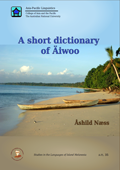
Studies in the Languages of Island Melanesia
 Studies in the Languages of Island Melanesia (SLIM) was an academic ebook series dedicated to peer-reviewed scholarly work on the languages of Island Melanesia. SLIM published six volumes, all Open access e-books, which can be downloaded freely from this page.
Studies in the Languages of Island Melanesia (SLIM) was an academic ebook series dedicated to peer-reviewed scholarly work on the languages of Island Melanesia. SLIM published six volumes, all Open access e-books, which can be downloaded freely from this page.
|
2017.
This is a short dictionary of the Äiwoo or Reefs language, which belongs to the Reefs-Santa Cruz group spoken in Solomon Islands' Temotu Province. It includes around 3,500 words in the Äiwoo language with English translations and examples of use, as well as an English-Äiwoo reversal list which makes it possible to find Äiwoo words based on their English translation.
The dictionary is intended to be useful both for speakers of Äiwoo and for researchers interested in the language. The Reefs-Santa Cruz languages are of interest to research on Oceanic languages because their ancestral language appears to have been spoken by one of the first groups of people to leave the Proto-Oceanic homeland more than 3,000 years ago. Knowing more about these languages will help us understand more about how the Pacific region was settled and of how languages of Temotu Province are related to the rest of the Oceanic language family. The dictionary is also intended as a tool for the people of the Reef Islands to help support and develop the continued use of their language. |
|
Alexandre François, Sébastien Lacrampe, Michael Franjieh; Stefan Schnell (eds) |
2015.
With an estimated 138 different indigenous languages, Vanuatu is the country with the highest linguistic density in the world. While they all belong to the Oceanic family, these languages have evolved in three millennia, from what was once a unified dialect network, to the mosaic of different languages that we know today. In this respect, Vanuatu constitutes a valuable laboratory for exploring the ways in which linguistic diversity can emerge out of former unity.
This volume represents the first collective book dedicated solely to the languages of this archipelago, and to the various forms taken by their diversity. Its ten chapters cover a wide range of topics, including verbal aspect, valency, possessive structures, numerals, space systems, oral history and narratives. The languages of Vanuatu: Unity and Diversity provides new insights onto the many facets of Vanuatu's rich linguistic landscape.
1. Alexandre François, Michael Franjieh, Sébastien Lacrampe, Stefan Schnell — The exceptional linguistic density of Vanuatu |
|
2015.
This book examines the different linguistic means used to describe or refer to
motion and location in space in Tungag, an Austronesian language spoken in
Papua New Guinea. The description, based on a spoken and written corpus of
about 100,000 words, includes a grammatical sketch of Tungag, in addition to a
detailed description of the linguistic means available for talking about motion.
Each of these strategies is defined and discussed in depth, using examples from
the corpus. Spatial language in Tungag is also approached from the perspective
of how these linguistic means are mapped onto motion events, and situated in
their typological context. Tungag does not fit well into the typology which
contrasts "satellite-framed" languages (encoding manner in the main verb and
path in a satellite to the verb) and "verb-framed" languages (encoding path in
the main verb and manner in a satellite or subordinate phrase). Instead, in
Tungag the combination possibilities for different elements of a motion event
are relatively free.
|
|
|
Jesse Lovegren, Alice Mitchell & Natsuko Nakagawa |
2015.
Wala (known as Langalanga in some sources) is an underdocumented Oceanic language spoken in west central Malaita, Solomon Islands, by approximately 7,000 speakers. The present book is a sketch grammar based on a 2007 New Testament translation published by Wycliffe Bible Translators. This work illustrates the extent to which basic grammatical patterns of a language can be inferred through the use of a computerized bilingual corpus, with access neither to native speaker consultants nor to the locale the language is used. Such an approach can be deployed either in preparation for fieldwork, or to generate documentation in cases where fieldwork is not feasible.
|
|
2013.
This is a grammatical description of the Lemakot dialect of Kara, an Oceanic language in the Lavongai-Nalik subgroup. It is spoken in the northwest part of New Ireland in Papua New Guinea, to the southeast of Tigak and to the northwest of Nalik. This description is based on the translation of the New Testament into Kara.
|
|
|
2012. |

 A short dictionary of Äiwoo
A short dictionary of Äiwoo






